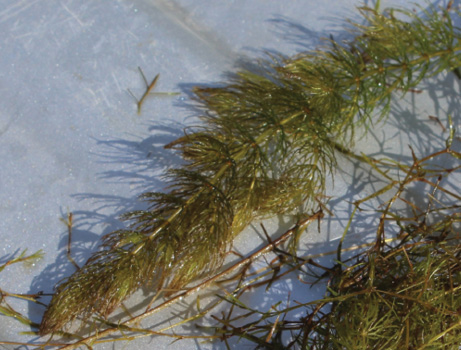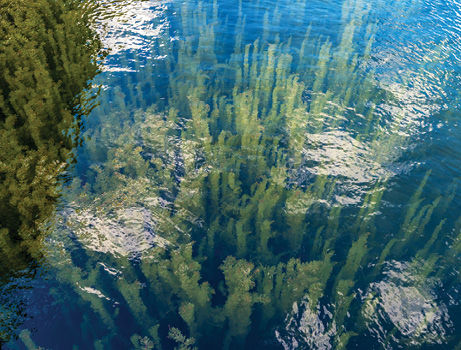Coontail | Ceratophyllum demersum
Submersed | Native

resembles the tail of a raccoon.


Coontail, sometimes called hornwort, is a rootless submerged plant that often forms dense growth in clear water. The leaves are completely submerged and never emergent.
It has dark green, relatively stiff, whorled leaves with many forks and small teeth along one edge. They are whorled around the stem with up to 12 leaves per whorl. Leaves are generally less than 0.6 inch long.
Stems can be long, up to 10 feet or more, and are branching, rope-like, and flexible. Coontail stems can be brittle and break easily. The tips of branches near the surface are crowded with leaves, making them resemble the tail of a raccoon. The plant is very rough to the touch.
Fruits are very small, less than 0.2 inch. They are smooth, tightly packed, and elliptical in shape.
Management Value
Coontail is a native plant that provides habitat to invertebrates and fish. Ducks eat the fruit. In small quantities, it is part of a healthy pond ecosystem, although it grows quickly and can take over aquatic habitats, even in deeper ponds.
Coontail is not generally recommended for establishment in small recreational ponds.
Recommended Controls
Option 1: Endothall (4.23-pound formulation). Endothall (0.75 gallon per acre-foot of water) should be applied as a submersed injection (subsurface application using a wand or hose). Determine pond volume prior to application. Do not exceed annual herbicide rate limits as stated on the product label.
Option 2: Flumioxazin (4.0-pound formulation). Flumioxazin should be applied as a submersed injection (2.1 pints per acre-foot of water). Determine pond volume prior to application. When mixing with water with pH greater than 7.0, use a buffering agent. Do not exceed annual herbicide rate limits as stated on the product label.
NOTE:Acre-foot = average depth of pond multiplied by pond acreage; average depth is calculated by taking the depth at 20 points across a water body and averaging the values.
Treat ponds when the water temperature is at least 60˚F and the plants are actively growing. It is best to treat one-third of the pond at a time for larger water bodies, with two weeks or more separating applications. After the entire pond has been treated, a repeat whole-pond application may be necessary to eliminate remaining plants.
Option 3: Triploid Grass Carp. Grass carp will eat coontail, but it is not a preferred food item. However, if no other food is available, stocking 10–15 fish per acre may provide control when herbicides are not an option. Stock 8- to 10-inch triploid grass carp in ponds that have established largemouth bass populations to avoid predation by bass. Note that abundant grass carp can impact other fish and can live up to 20 years.
If herbicides are used to control coontail, consider stocking three to five triploid grass carp per acre to prevent re-infestation. Stock 8- to 10-inch triploid grass carp in ponds that have established largemouth bass populations to avoid predation by bass.
Read and follow all chemical label instructions, especially the section on the use of personal protection equipment.
Photo Credits Top: A. Merkulova, Creative Commons

The information given here is for educational purposes only. References to commercial products, trade names, or suppliers are made with the understanding that no endorsement is implied and that no discrimination against other products or suppliers is intended.
Publication 3735-7 (POD-11-23)
By Wes Neal, PhD, Extension/Research Professor, Wildlife, Fisheries, and Aquaculture; Dennis Riecke, Fisheries Coordinator, Mississippi Department of Wildlife, Fisheries, and Parks; and Gray Turnage, PhD, Assistant Research/Extension Professor, GeoSystems Research Institute.
The Mississippi State University Extension Service is working to ensure all web content is accessible to all users. If you need assistance accessing any of our content, please email the webteam or call 662-325-2262.



